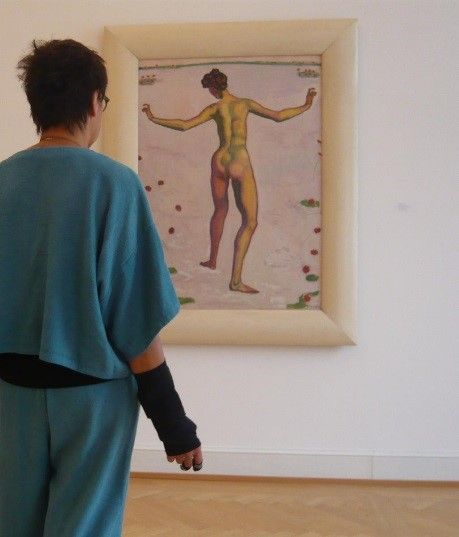Art Appreciation: Beyond the Brain
Art and science are often depicted as near opposites. However, new research illuminates how the latter is intricately connected with the former.

When viewing art, some museum-goers get that loving feeling. They like what they see and they see what they like. A few go so far as to have a religious experience of sorts and report sensations of euphoria. These perceptions, originating in the brain, aren’t all that is going on in a museum visitors’ body. The area below the neck is also engaged.
Psychologist Wolfgang Tschacher and colleagues from institutes in Switzerland and Germany recently demonstrated this to be true. They examined the physical responses of 373 museum visitors to the Kunstmuseum St. Gallen, in Switzerland. By using a specially made glove on the visitor’s right hand, their motion, heart rate, and skin conductance levels were determined wirelessly.

Photo from “Mapping the Museum Experience.” The visitor in a study is wearing the especially made glove that monitors motion, heart rate, and skin conductance levels wirelessly.
Sixty-five percent of the participants in the study were female. The average age of all was 47 years. Each subject spent on average of 28 minutes in the exhibit.
Skin conductance levels (SCL) measure the electrical current readings of the skin which vary with its moisture level. Differences are associated with emotion because the involuntary sympathetic nervous system responsible for the fight or flight response controls SCL. Thus, when someone is excited, activity in the sweat gland is increased which elevates skin resistance. This is recorded as a measure of emotional response.
An immediate post-visit customized computer questionnaire was used to evaluate responses to the 3 artworks where the participant lingered the longest (determined by the motion sensors in the glove). Responses to 3 artworks chosen in advance by the investigators were presented as well. Five areas of aesthetic appreciation were assessed.
“Aesthetic Quality”: Pleasing; beautiful; well done with respect to technique, composition, and content
“Surprise/Humor”: The work is considered as surprising; makes one laugh
“Negative Emotion”: The work conveys sadness, fear, anger
“Dominance”: The work is experienced as dominant, stimulating
“Curatorial Quality”: The work is well staged and hung, suitable in the context of other artworks
Using statistical measures, the researchers found that 3 of the 4 physiological measures used to determine biological responses to art in the museum showed significance.
Beautiful, high-quality artworks and surprising or humorous pieces were significantly associated with a higher heart rate variability.
Works of art perceived as dominant were significantly associated with a higher skin conductance variability.
Dominant art was also associated significantly with a decrease in heart rate.
Interestingly enough, only skin conductance absolute levels were unassociated with any parameter.
Tschacher and his colleagues were sparse in explaining any meaning this might have for their participants, though this wasn’t really necessary. Their major conclusion stands on its own: there are measurable physiological response to artworks in a museum. The authors sum this up by saying, “Our findings suggest that an idiosyncratically human property—finding aesthetic pleasure in viewing artistic artifacts—is linked to biological markers.” Our appreciation of art is not all in our heads!
Love/Hate: A Real Life Example
Every year the Design Arts Society at the Indianapolis Museum of Art has what is called a “Love/Hate” evening. During the event, members of the group present their impression of the best and worst design in the galleries. The occasion is meant to be thought provoking so those that are not presenters will join in a lively discussion.
Recently, at one such event, David Force, a member of the group and presenter for the evening made this comment when he offered David Stark’s bedside gun lamp as an object of hate. The piece, basically in your face, and certainly dominant, stimulated Force to say, “My heart rate must be going down.”